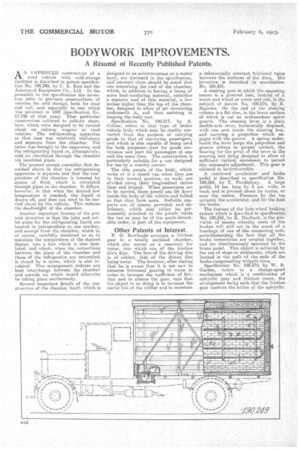BODYWORK 'IMPROVEMENTS.
Page 28

If you've noticed an error in this article please click here to report it so we can fix it.
A Résumé of Recently Published Patents.
A. N IMPROVED construction of a road vehicle with cold-storage facilities is described in patent specification No. 190,249, by C. E. Esse and the Associated Equipment Co., Ltd. In the preamble to the specification the inventors refer to previous constructions of vehicles for cold storage, both for road and rail, and especially to one which was patented in 1887 (specification No. 17,756 of that year). That particular construction referred to cold-air chambers, which were designed to be carried about on railway wagons or road vehicles. The refrigerating apparatus in that case was relatively stationary and separate from the chamber. The latter was brought to the apparatus, and the refrigerating liquid or, alternatively, cold air circulated through the chamber
via insulated pipes. .
The present system resembles that described above in that the refrigerating apparatus is separate and that the temperature of the chamber is lowered by means of fluid, which is circulated through pipes in the chamber. It differs, however, in that when the desired low temperature is reached, the liquid, is drawn off, and does not need to be carried about by the vehicle. This reduces the deadweight of the chamber.
Another important feature of the present. invention is that the inlet and outlet pipes for the refrigerating liquid are located in juxtaposition to one another, and emerge from the chamber, which is, of course, carefully insulated so as to maintain the temperature at the desired degree, into a box which is also insulated, and which, when the connections between the pipes of the chamber and those of the refrigerator are uncoupled, is closed by a cover, which is also in. sulated. Thus arrangement reduces any heat interchange between the chamber and outside air which would otherwise be taking place continuously.
Several important details of the conatructioo of the chamber itself, which is
designed to be accommodated on a motor lorry, are disclosed in the specification, and amongst them should be noted that one concerning the roof of the chamber, which, in addition to having a lining of some heat-insulating material, embodies a separate roof -of thin material, a few inches higher than the top of the chamber, designed to allow of air circulating underneath it, and thus assisting in keeping the body cool.
Specification No. 190,217, by A. Collier, refers to -that type of motor vehicle body which may be ileadily converted from the purpose of carrying goods to that of conveying passengers, and which is also capable of being used for both purposes—part for goods conveyance and part for passengers at one and the same time. The construction is particularly suitable for a van designed for use by a country carrier.
The side panels of the body, which make of it a dosed van when they are in their normal position, as such, are divided along their longitudinal centre lines and hinged. When passengers are to he carried, these panels are let down inside•the body of the vehicle and folded so that they form seats. Suitable supports are, of course, provided, and upholstery, which may either be, permanently attached to the panels inaide the van or may be of the quick-detachable order, is part of the equipment.
. Other Patents of Interest.
P. 0. Rowlands. arranges a friction gear in a totally enclosed chamber, which also Serves as a reservoir for water, into which one of the friction discs dips. The face of the driving disc is of rubber, that of the driven disc being metal. The inventor, after stating that he is aware that it is not new to immerse frictional gearing in water in order to increase the coefficient of friction and to silence the gear, says that his object in so doing is to increase the useful life of the rubber and to maintain a substantially constant frictional value between the surfaces of the discs. rilia invention is described in BpeciikAtion. No. 190,431.
A steering gear in which the operating means is a grooved cam, instead, of worm and wheel or screw and nut, is the subject of patent No. 190,676, hy E. Zaparka. On the end of the steering column is a fiat disc, in the lower surface of which is cut an archimedean spiral groove. The steering lever is a plain double-arm lever, horizontally disposed, with one arm inside the steering box, and carrying a projection which engages with the groove. A spring underneath the lever keeps the projection and groove -always in proper contact, the bearing for the pivot of the lever in the steering box being designed to allow of sufficientvertical movement to permit this automatic adjustment. This gear is claimed to belirreversible.
A combined accelerator and brake pedal is described in specification No. 190,684, by T. Pendlebury. A large pedal, 14 ins, long by 5 ins, wide, is wed, and is pivoted about its centre, or near the centre. Pressure by the toe actuates the accelerator, and by the heel the brake.
The featbre of the four-wheel braking system which is *scribed in specification No 190,565; by K. Maybach, is the provision of 'means whereby some of the brakes will still act in the event of a breakage ,af one of the connecting rods, notwithstanding . the fact that all the brake'connections are coupled together, and are simultaneously operated. by the brake pedal. This object is achieved. by the use of stops or abutments, which are located in the path of the ends of the brake-compensating Whipple trees.
Specification No. 190,578, by W. B. Garden, refers to a change-speed mechanism which is a combination of epicyclic gear and friction cones, the arrangement being such thatthe I net on gear controls the action of the epicyclie.




























